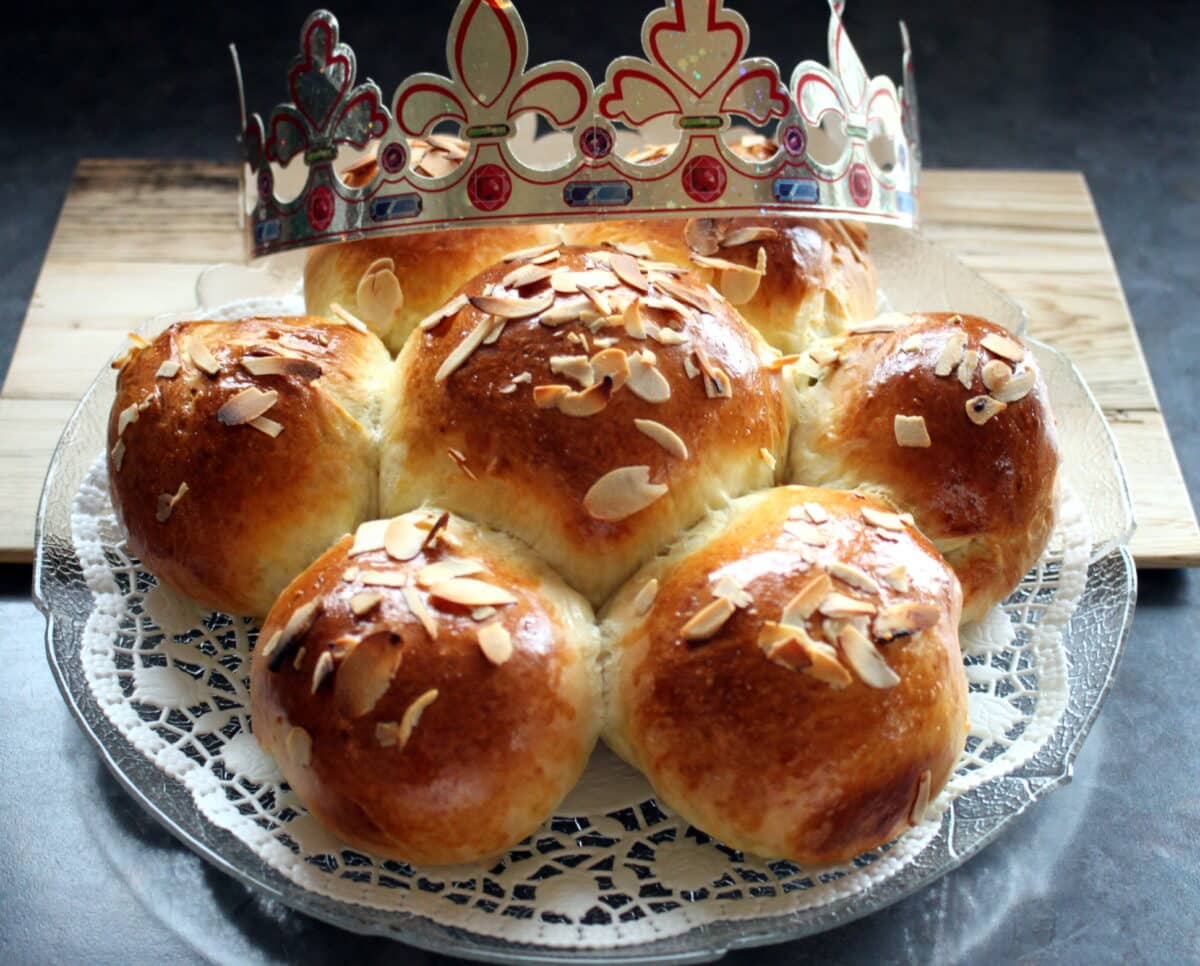A small king made of plastic is baked into the Swiss "king" cake.
January 6 is a very special day in Switzerland
In Switzerland, we celebrate the three kings who brought gifts to the newborn Christ child. For this, my mom baked a typically Swiss “Three Kings Cake,” though they can also be bought it at a bakery. In the folk customs of the Western Church, the feast of Epiphany is represented by the three kings, the Wise Men from the East seen in nativity scenes. The Wise Men are considered by tradition to be the first missionaries who brought the Good News to the whole world. For this reason, the feast of Epiphany is considered the oldest missionary feast.
January 6 is a very special day!
In Switzerland, we celebrate the Three Kings, who bring gifts to the newborn child. For this, my mom baked a Three Kings cake, typically Swiss! (or you bought it at the baker) In this cake was hidden a little king and who found it in his piece, was king for one day. In the folk customs of the Western Church, the feast of Epiphany was reduced to the motif of the three kings, the wise men from the East. In nativity scenes, three wise men from the Orient are added to the figures on Epiphany. The Wise Men from the East are considered by tradition to be the first missionaries who brought the Good News to the whole world. For this reason, the feast of Epiphany is considered the oldest missionary feast.
Unknown content block type: FlexiblePageTemplateFlexibleContentPhotoFullWidthLayout
{
"__typename": "FlexiblePageTemplateFlexibleContentPhotoFullWidthLayout"
}In Switzerland, Epiphany cake is made from sweet yeast dough that is formed into balls, arranged in a flower shape, and sprinkled with flaked almonds and coarse sugar.
But other countries also celebrate this day with their special pastries.
Thanks to the wonderful members of thecookscookcommunityforum on Facebook who have shared their creations.
In Germany
According to the guidelines for fine baked goods, Königskuchen is made of sand mass with candied fruit. The old German Königskuchen is made of particularly heavy sand mass, while the Rhineland-style Königskuchen is additionally baked wrapped in puff pastry.
In Portugal
In Portugal (and in Brazil), the Epiphany cake is known as bolo rei. It is made of yeast dough similar to brioche, and decorated with candied fruit. Coming to Portugal via France in the 19th century, the bolo rei is usually shaped like a crown (round with an opening in the center).
In France
In France there are two types of cakes. In the north of France, people traditionally eat the galette des rois made of puff pastry, often with a marzipan filling. In the south, there is the couronne or gâteau des rois, made from brioche dough and filled or decorated with candied fruit. A porcelain figurine is hidden in each cake.
Unknown content block type: FlexiblePageTemplateFlexibleContentPhotoFullWidthLayout
{
"__typename": "FlexiblePageTemplateFlexibleContentPhotoFullWidthLayout"
}In Spain
The Roscón de Reyes (“King’s Wreath”) is a traditional wreath cake made of yeast dough, baked for the Feast of the Three Kings on January 6. It is available in several variations: without filling, with whipped cream, with truffle filling, with custard cream or as cabello de ángel. Hidden inside each is a porcelain figurine and a dry bean that must not be eaten under any circumstances. The tradition says that the one who finds the bean in his piece of cake will have to pay for the cake for all the guests. On the other hand, the one who is lucky enough to find the small porcelain figurine is crowned “king” by everyone. The wreath cake is decorated with candied fruits such as orange slices, red and green cherries, etc.
Unknown content block type: FlexiblePageTemplateFlexibleContentPhotoFullWidthLayout
{
"__typename": "FlexiblePageTemplateFlexibleContentPhotoFullWidthLayout"
}In Latin America
The tradition of Rosca de Reyes (“King’s Wreath”) was introduced to Mexico by Spain in the 16th century. The cake is made of yeast dough and usually without filling, baked only for the feast of the Magi on January 6. The wreath cake is decorated with candied desert fruits such as dates, figs, and the like. Hidden inside are several porcelain or ceramic figurines, according to one’s choice. The tradition says that the one who finds a porcelain child must bake tamales for all the guests. The feast is then celebrated on February 2, the Fiesta de la Candelaria (Candlemas).
Unknown content block type: FlexiblePageTemplateFlexibleContentPhotoFullWidthLayout
{
"__typename": "FlexiblePageTemplateFlexibleContentPhotoFullWidthLayout"
}United States
The tradition of King Cake in Louisiana, and particularly in New Orleans for Mardi Gras, was established by French immigrants and dates back to the 19th century. These immigrants brought both the Northern French Galette des Rois made of puff pastry with marzipan filling (now known as French King Cake) and the Southern French version of the colorfully decorated yeast dough ring (now known as King Cake) to New Orleans, where both versions exist to this day. Common to both varieties is that a small plastic baby figurine, symbolizing the newborn Christ child, is hidden in the cake (in the past, nuts, beans, peas or coins were used). The finder is the king or queen of the day and must host the next King Cake party.
Unknown content block type: FlexiblePageTemplateFlexibleContentPhotoFullWidthLayout
{
"__typename": "FlexiblePageTemplateFlexibleContentPhotoFullWidthLayout"
}Stay Updated on New Features
Get notified about new stories, insights, and culinary adventures from our team.
